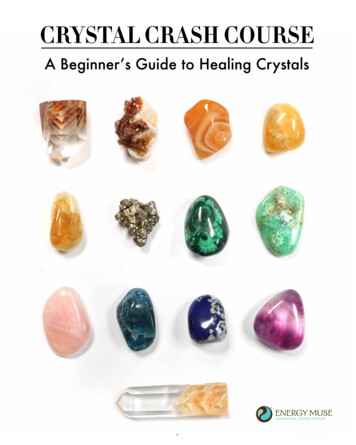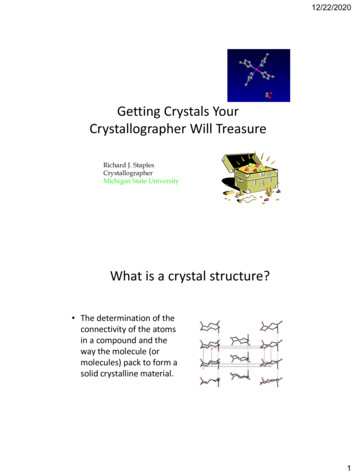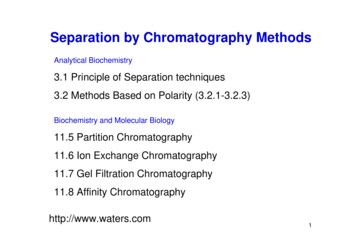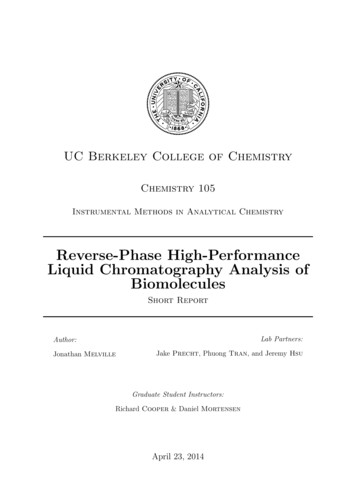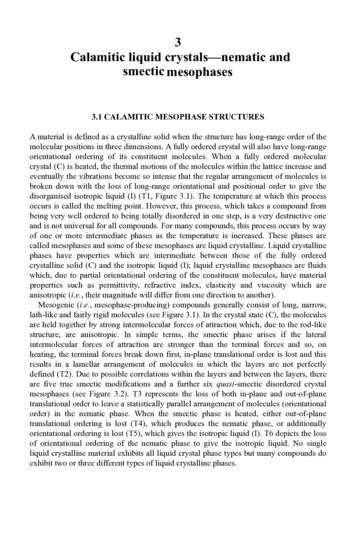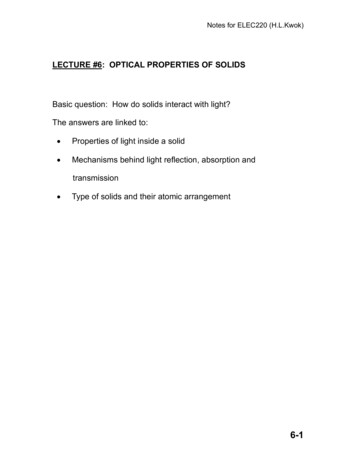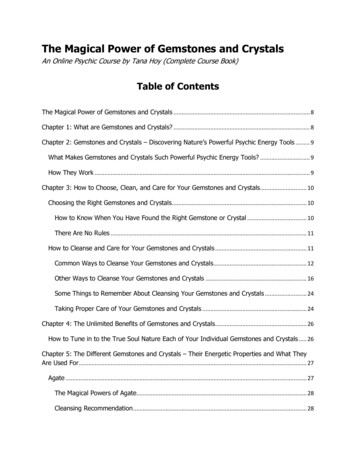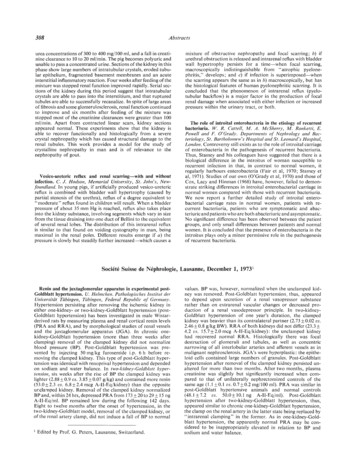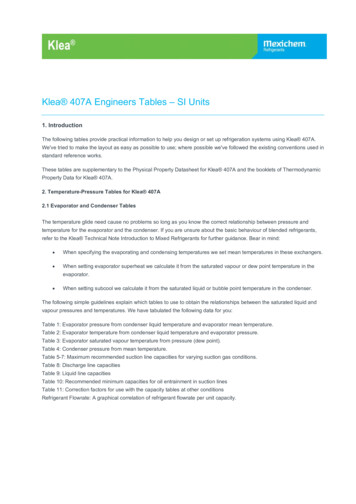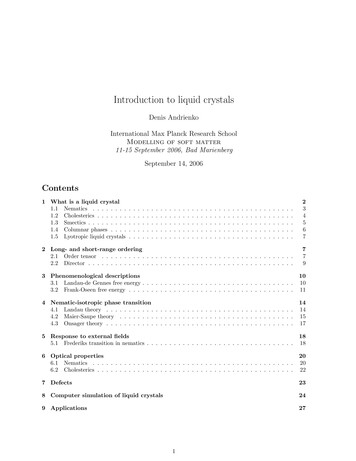
Transcription
Introduction to liquid crystalsDenis AndrienkoInternational Max Planck Research SchoolModelling of soft matter11-15 September 2006, Bad MarienbergSeptember 14, 2006Contents1 What is a liquid crystal1.1 Nematics . . . . . . . .1.2 Cholesterics . . . . . . .1.3 Smectics . . . . . . . . .1.4 Columnar phases . . . .1.5 Lyotropic liquid crystals.2345672 Long- and short-range ordering2.1 Order tensor . . . . . . . . . . . . . . . . . . . . . . . . . . . . . . . . . . . . . . . . . . .2.2 Director . . . . . . . . . . . . . . . . . . . . . . . . . . . . . . . . . . . . . . . . . . . . . .7793 Phenomenological descriptions3.1 Landau-de Gennes free energy . . . . . . . . . . . . . . . . . . . . . . . . . . . . . . . . . .3.2 Frank-Oseen free energy . . . . . . . . . . . . . . . . . . . . . . . . . . . . . . . . . . . . .1010114 Nematic-isotropic phase transition4.1 Landau theory . . . . . . . . . . . . . . . . . . . . . . . . . . . . . . . . . . . . . . . . . .4.2 Maier-Saupe theory . . . . . . . . . . . . . . . . . . . . . . . . . . . . . . . . . . . . . . .4.3 Onsager theory . . . . . . . . . . . . . . . . . . . . . . . . . . . . . . . . . . . . . . . . . .141415175 Response to external fields5.1 Frederiks transition in nematics . . . . . . . . . . . . . . . . . . . . . . . . . . . . . . . . .18186 Optical properties6.1 Nematics . . . . . . . . . . . . . . . . . . . . . . . . . . . . . . . . . . . . . . . . . . . . .6.2 Cholesterics . . . . . . . . . . . . . . . . . . . . . . . . . . . . . . . . . . . . . . . . . . . .2020227 Defects238 Computer simulation of liquid crystals249 Applications27.1.
LiteratureMany excellent books/reviews have been published covering various aspects of liquid crystals. Amongthem:1. The bible on liqud crystals: P. G. de Gennes and J. Prost “The Physics of Liquid Crystals”, Ref. [1].2. Excellent review of basic properties (many topics below are taken from this review): M. J. Stephen,J. P. Straley “Physics of liquid crystals”, Ref. [2].3. Symmetries, hydrodynamics, theory: P. M. Chaikin and T. C. Lubensky “Principles of CondensedMatter Physics”, Ref. [3].4. Defects: O. D. Lavrentovich and M. Kleman, “Defects and Topology of Cholesteric Liquid Crystals”, Ref. [4]; Oleg Lavrentovich “Defects in Liquid Crystals: Computer Simulations, Theory andExperiments”, Ref. [5].5. Optics: Iam-Choon Khoo, Shin-Tson Wu, “Optics and Nonlinear Optics of Liquid Crystals”,Ref. [6].6. Textures: Ingo Dierking “Textures of Liquid Crystals”, Ref. [7].7. Simulations: Michael P. Allen and Dominic J. Tildesley “Computer simulation of liquids”, Ref. [8].8. Phenomenological theories: Epifanio G. Virga “Variational Theories for Liquid Crystals”, Ref. [9].Finally, the pdf file of the lecture notes can be downloaded fromhttp://www.mpip-mainz.mpg.de:/ andrienk/lectures/IMPRS/liquid crystals.pdf.1What is a liquid crystalThere is always a reason behind everything and this principle does not exclude naming conventions inphysics. Hence, to understand what is a “liquid crystal” we need to clarify why would one give such aname to a substance.At first, the notion “liquid crystal” seems to be absurd. It, however, suggests that it is an intermediatestate of a matter, in between the liquid and the crystal. It must possess some typical properties of aliquid (e. g. fluidity, inability to support shear, formation and coalescence of droplets) as well as somecrystalline properties (anisotropy in optical, electrical, and magnetic properties, periodic arrangement ofmolecules in one spatial direction, etc.).Certain structural features are often found in molecules forming liquid crystal phases, and they maybe summarized as follows:1. The molecules have anisotropic shape (e. g. are elongated). Liquid crystallinity is more likely tooccur if the molecules have flat segments, e. g. benzene rings.2. A fairly good rigid backbone containing double bonds defines the long axis of the molecule.3. The existence of strong dipoles and easily polarizable groups in the molecule seems important.4. The groups attached to the extremities of the molecules are generally of lesser importance.2
Figure 1: The arrangement of molecules in liquid crystal phases. (a) The nematic phase. The moleculestend to have the same alignment but their positions are not correlated. (b) The cholesteric phase. Themolecules tend to have the same alignment which varies regularly through the medium with a periodicitydistance p/2. The positions of the molecules are not correlated. (c) smectic A phase. The molecules tendto lie in the planes with no configurational order within the planes and to be oriented perpendicular tothe planes.1.1NematicsThe nematic phase is characterized by long-range orientational order, i. e. the long axes of the moleculestend to align along a preferred direction. The locally preferred direction may vary throughout the medium,although in the unstrained nematic it does not. Much of the interesting phenomenology of liquid crystalsinvolves the geometry and dynamics of the preferred axis, which is defined by a vector n(r) giving itslocal orientation. This vector is called a director. Since its magnitude has no significance, it is taken tobe unity.There is no long-range order in the positions of the centers of mass of the molecules of a nematic,but a certain amount of short-range order may exist as in ordinary liquids. The molecules appear to beable to rotate about their long axes and also there seems to be no preferential arrangement of the twoends of the molecules if they differ. Hence the sign of the director is of no physical significance, n n.Optically a nematic behaves as a uniaxial material with a center of symmetry. A simplified picture ofthe relative arrangement of the molecules in the nematic phase is shown in Fig. (1a). The long planarmolecules are symbolized by ellipses.Figure 2: (a) Schlieren texture of a nematic film with surface point defects (boojums). (b) Thin nematicfilm on isotropic surface: 1-dimensional periodicity. Photos courtesy of Oleg Lavrentovich http://www.lci.kent.edu/ALCOM/oleg.html. (c) Nematic thread-like texture. After these textures the nematicphase was named, as “nematic” comes from the Greek word for “thread”. Photo courtesy of IngoDierking.On optical examination of a nematic, one rarely sees the idealized equilibrium configuration. Somevery prominent structural perturbation appear as threads from which nematics take their name (Greek3
“νηµα” means thread). These threads are analogous to dislocations in solids and have been termeddisclinations by Frank.Several typical textures of nematics are shown in Fig. (2). The first one is a schlieren texture of anematic film. This picture was taken under a polarization microscope with polarizer and analyzer crossed.From every point defect emerge four dark brushes. For these directions the director is parallel either tothe polarizer or to the analyzer. The colors are newton colors of thin films and depend on the thicknessof the sample. Point defects can only exist in pairs. One can see two types of boojums with “oppositesign of topological charge”; one type with yellow and red brushes, the other kind not that colorful. Thedifference in appearance is due to different core structures for these defects of different “charge”.The second texture is a thin film on isotropic surface. Here the periodic stripe structure is a spectacularconsequence of the confined nature of the film. It is a result of the competition between elastic innerforces and surface anchoring forces. The surface anchoring forces want to align the liquid crystals parallelto the bottom surface and perpendicular to the top surface of the film. The elastic forces work againstthe resulting “vertical” distortions of the director field. When the film is sufficiently thin, the lowestenergy state is surprisingly archived by “horizontal” director deformations in the plane of the film. Thecurrent picture shows a 1-dimensional periodic pattern.Many compounds are known to form nematic mesophase. A few typical examples are sketched inFig. (3). From a steric point of view, molecules are rigid rods with the breadth to width ratio from 3:1to 20:1.Figure 3: Typical compounds forming nematic mesophases: (PAA) p-azoxyanisole. From a rough stericpoint of view, this is a rigid rod of length 20Å and width 5Å. The nematic state is found at hightemperatures (between 1160 C and 1350 C at atmospheric pressure). (MMBA) N -(p-methoxybenzylidene)p-butylaniline. The nematic state is found at room temperatures (between 200 C to 470 C). Lacks chemicalstability. (5CB) 4-pentyl-4’-cyanobiphenyl. The nematic state is found at room temperatures (between240 C and 350 C).1.2CholestericsThe cholesteric phase is like the nematic phase in having long-range orientation order and no long-rangeorder in positions of the centers of mass of molecules. It differs from the nematic phase in that the directorvaries in direction throughout the medium in a regular way. The configuration is precisely what one wouldobtain by twisting about the x axis a nematic initially aligned along the y axis. In any plane perpendicularto the twist axis the long axes of the molecules tend to align along a single preferred direction in this4
plane, but in a series of equidistant parallel planes, the preferred direction rotates through a fixed angle,as illustrated in Fig. (1b).The secondary structure of the cholesteric is characterized by the distance measured along the twistaxis over which the director rotates through a full circle. This distance is called the pitch of the cholesteric.The periodicity length of the cholesteric is actually only half this distance since n and n are indistinguishable.A nematic liquid crystal is just a cholesteric of infinite pitch, and is not really an independent case.In particular, there is no phase transition between nematic and cholesteric phases in a given material,and nematic liquid crystals doped with enantiomorphic materials become cholesterics of long (but finite)pitch. The molecules forming this phase are always optically active, i. e. they have distinct right- andleft-handed forms.Figure 4: (a) Cholesteric fingerprint texture. The line pattern is due to the helical structure of thecholesteric phase, with the helical axis in the plane of the substrate. Photo courtesy of Ingo Dierking. (b)A short-pitch cholesteric liquid crystal in Grandjean or standing helix texture, viewed between crossedpolarizers. The bright colors are due to the difference in rotatory power arising from domains withdifferent cholesteric pitch occuring on rapid cooling close to the smectic A* phase where the pitch stronglydiverges with decreasing temperature. Photo courtesy of Per Rudqvist. (c) Long-range orientation ofcholesteric liquid crystalline DNA mesophases occurs at magnetic field strengths exceeding 2 Tesla. Theimage presented above illustrates this long-range order in DNA solutions approaching 300 milligrams permilliliter. Parallel lines denoting the periodicity of the cholesteric mesophase appear at approximately45-degrees from the axis of the image boundaries.The pitch of the common cholesterics is of the order of several hundreds nanometers, and thus comparable with the wavelength of visible light. The spiral arrangement is responsible for the characteristiccolors of cholesterics in reflection (through Bragg reflection by the periodic structure) and their very largerotatory power. The pitch can be quite sensitive to temperature, flow, chemical composition, and appliedmagnetic or electric field. Typical cholesteric textures are shown in Fig. (4).1.3SmecticsThe important feature of the smectic phase, which distinguishes it from the nematic, is its stratification.The molecules are arranged in layers and exhibit some correlations in their positions in addition to theorientational ordering. A number of different classes of smectics have been recognized. In smectic Aphase the molecules are aligned perpendicular to the layers, with no long-range crystalline order withina layer (see Fig. (1c)). The layers can slide freely over one another. In the smectic C phase the preferredaxis is not perpendicular to the layers, so that the phase has biaxial symmetry. In smectic B phase thereis hexagonal crystalline order within the layers.In general a smectic, when placed between glass slides, does not assume the simple form of Fig. (1c).The layers, preserving their thickness, become distorted and can slide over one another in order to adjustto the surface conditions. The optical properties (focal conic texture) of the smectic state arise fromthese distortions of the layers. Typical textures formed by smectics are shown in Fig. (5).5
Figure 5: (a,b) Focal-conic fan texture of a chiral smectic A liquid crystal (courtesy of ChandrasekharS., Krishna Prasad and Gita Nair) (c) Focal-conic fan texture of a chiral smectic C liquid crystal. Moreimages are available here: http://www.chem.warwick.ac.uk/jpr/lq/liqcry.htmlA number of substances exhibit nematic (or cholesteric) and smectic phases. The general rule appearsto be that the lower temperature phases have a greater degree of crystalline order. Examples are: (i) thenematic phase always occurs at at a higher temperature than the smectic phase; (ii) the smectic phasesoccur in the order A C B as the temperature decreases.1.4Columnar phasesFigure 6: (a) hexagonal columnar phase Colh (with typical spherulitic texture); (b) Rectangular phaseof a discotic liquid crystal (c) hexagonal columnar liquid-crystalline phase.Figure 7:Typical discotics:derivative of ahexakishexyloxytriphenylene. K(70K) Colh (100K) I.hexabenzocoroneneand2,3,6,7,10,11-Disk-shaped mesogens can orient themselves in a layer-like fashion known as the discotic nematicphase. If the disks pack into stacks, the phase is called a discotic columnar. The columns themselves6
Figure 8: (1) Columnar phase formed by the disc-shaped molecules and the most common arrangementsof columns in two-dimensional lattices: (a) hexagonal, (b) rectangular, and (c) herringbone. (2,3) MDsimulation results: snapshot of the hexabenzocoronene system with the C12 side chains. Aromatic coresare highlighted. Both top and side views are shown. T 400 K, P 0.1 MPa.may be organized into rectangular or hexagonal arrays, see Fig. (8). Chiral discotic phases, similar tothe chiral nematic phase, are also known.The columnar phase is a class of liquid-crystalline phases in which molecules assemble into cylindricalstructures to act as mesogens. Originally, these kinds of liquid crystals were called discotic liquid crystalsbecause the columnar structures are composed of flat-shaped discotic molecules stacked one-dimensionally.Since recent findings provide a number of columnar liquid crystals consisting of non-discoid mesogens, itis more common now to classify this state of matter and compounds with these properties as columnarliquid crystals.Columnar liquid crystals are grouped by their structural order and the ways of packing of the columns.Nematic columnar liquid crystals have no long-range order and are less organized than other columnarliquid crystals. Other columnar phases with long-range order are classified by their two-dimensionallattices: hexagonal, tetragonal, rectangular, and oblique phases.The discotic nematic phase includes nematic liquid crystals composed of flat-shaped discotic moleculeswithout long-range order. In this phase, molecules do not form specific columnar assemblies but onlyfloat with their short axes in parallel to the director (a unit vector which defines the liquid-crystallinealignment and order).1.5Lyotropic liquid crystalsLiquid crystals which are obtained by melting a crystalline solid are called thermotropic. Liquid crystalline behavior is also found in certain colloidal solutions, such as aqueous solutions of tobacco mosaicvirus and certain polymers. This class of liquid crystals is called lyotropic. For this class concentration(and secondarily temperature) is the important controllable parameter, rather then temperature (andsecondarily pressure) as in the thermotropic phase. Most of the theories outlined below is equally validfor either class, although we will generally have a thermotropic liquid crystal in mind.22.1Long- and short-range orderingOrder tensorWe will first try to characterize a nematic mesophase. Suppose that the molecules composing a nematicare rigid and rod-like in shape. Then we can introduce a unit vector u(i) along the axis of ith moleculewhich describes its orientation. Since liquid crystals possess a center of symmetry, the average of u(i)vanishes. It is thus not possible to introduce a vector order parameter for a liquid crystals analogous to7
Figure 9: Orientation of mesogens in a nematic phase. A unit vector u(i) along the axis of ith moleculedescribes its orientation. The director n shows the average alignment.the magnetization in a ferromagnet, and it is necessary to consider higher harmonics (i. e. tensors). Anatural order parameter to describe the ordering in nematics (or cholesteric) is the second rank tensor 1 X (i) (i) 1Sαβ (r) uα uβ δαβ(1)N i3when the sum is over all the N molecules in a small but macroscopic volume located at the point r;indexes α, β (x, y, z).Properties of the order parameter tensor1. Sαβ is a symmetric tensorSαβ Sβα ,(i) (i)(2)(i) (i)since uα uβ uβ uα and δαβ δβα .2. It is tracelessTrSαβ XSαα α (x,y,z) 1 X12(i) 2(i) 2(u(i)) (u) (u) 3 1 1 0,xyzN i3(3)since u is a unit vector.3. Two previous properties (symmetries) reduce the number of independent components (3 by 3 matrix) from 9 to 5.iso4. In the isotropic phase Sαβ 0.To prove this, let us transform everything to the spherical coordinate system (in the isotropic phaseall directions are equivalent - spherical coordinates allow simple formulation of this fact)ThenZ2πuxuyuz sin θ cos φ sin θ sin φ cos θπ ZdφSαβ 00 1sin θdθP (θ, φ) uα uβ δαβ ,3(4)(5)where P (θ, φ) is the probability to find a molecule with the orientation given by the angles θ, φ.8
It is clear that in the isotropic phase Piso is a constant. Normalization conditions require that1Piso (θ, φ) 4π. Indeed,Z 2πZ π/22dφsin θdθ 4π.(6)00Note that the integration over θ is from 0 to π/2, but we double the value of the integral tocompensate for the conventional integration from 0 to π in spherical coordinates. This is due thefact the u and u are indistinguishable (for unpolar molecules), but we nevertheless describe theirorientations using vectors, for which the opposite directions are of course distinguishable.It is easy to see that in the isotropic phase the cross terms Sxy Syz Sxz 0 because of theintegration over φ (periodic function integrated over its full period). Let us consider one of thediagonal components, for example Szz Z 2πZ π/21 (7)Szz 2dφsin θdθP (θ, φ) cos2 θ 300 Z 1 21124πPisod(cos θ) π (x3 x) 0 0.cos θ 330In a similar fashion one can show that the other two diagonal components are also equal to zero.5. In a perfectly aligned nematic (with the molecules along the z axis), prolate geometry 1/300 1/30 .S prolate 0002/3(8)To prove this it is sufficient to calculate only the Szz component:Szz uz uz 1/3 1 1/3 2/3.(9)Keeping in mind that S is symmetric and traceless we obtain (8).6. In a perfectly aligned oblate geometry (uz 0) 1/6S oblate 00 001/60 .0 1/3(10)These properties tell us that Sαβ is a very good candidate for the order parameter of our system.It equals to zero in the isotropic phase, it is sensitive to the direction of the average orientation of themolecules as well as to the molecular distribution of the molecules around the their average orientation.It is indeed often used to describe “difficult” situations, which include presence of defects, melting ofparts of the system, i. e. where the order parameter is a function of spatial coordinates (in the defectcore region, at the nematic-isotropic interface, etc.).2.2DirectorIn the previous section we showed that the order tensor is a suitable candidate for an order parameter of anematic mesophase. It is, however, rather inconvenient to use since it lacks clear physical interpretation.Indeed, in some special cases we can find a more convenient representation, especially in those systemswhere the degree of ordering is not changing and therefore only the average orientation of the moleculesis of interest.In general, any symmetric second-order tensor has 3 real eigenvalues and three corresponding orthogonal eigenvectors. (Recall gyration tensor or mass and inertia tensor). Since this tensor is a symmetric9
3 3 matrix, a Cartesian coordinate system can be found in which it is diagonal with the diagonalelements 23 S, 13 S B, 31 S B (principal moments in case of a gyration tensor). Here the eigenvaluesare ordered such as S has the biggest aboslute value. The corresponding eigenvector is called a director,n(r). B is a biaxiality of the molecular distribution.For a uniaxial nematic phase (molecular distribution function has an axial symmetry) two smallereigenvalues are equal (B 0) and the order tensor reads Sαβ1 S nα nβ δαβ3 (11)where nα are the components of n in a laboratory (fixed) coordinate system.If we choose n along the z axis of the coordinate system, the three nonzero components of S areSzz 2S,31Sxx Syy S.2(12)The scalar quantity S is a measure of the degree of alignment of molecules. Quantitatively, if P (θ) sin θdθis the fraction of molecules whose axes make angles between θ and θ dθ with the preferred direction Z π 3S 1 sin2 θ P (θ)dθ.(13)20In the isotropic phase S 0, and in the nematic (cholesteric) phase 0 S 1. The limit S 1corresponds to perfect alignment of all the molecules and, of course, can never be realized in practice. Ifwe compare Eq. (11) to two previous cases of ideal prolate and oblate molecular distributions, we willsee that negative values of S correspond to a pancake-like (oblate) molecular distribution, positive valuesdescribe prolate-like distributions, and isotropic liquid has S 0. In general, it can be shown that thescalar order parameter S changes in the range from 1/2 to 1 (from perfect oblate to perfect prolategeometry via isotropic phase).The most important classes of liquid crystals belong to the uniaxial case (the smectic C is a typicalcounter example). The order parameter for all such systems can be characterized by a magnitude S anda direction n, where the latter is the principal axis of the order parameter tensor.The theoretical development depends merely upon the existence of n and is by no means restrictedto the case of rigid symmetric molecules.33.1Phenomenological descriptionsLandau-de Gennes free energyOnce the appropriate order parameter of the system is identified (here the order tensor Sαβ ) we canassume, in a spirit of Landau theories, that the free energy density g(P, T, Sαβ ) is an analytic function ofthe order parameter tensor Sαβ . To the extent that Sαβ is a small parameter, we may expand g in powerseries. In particular this expansion is supposed to work well near the transition temperature. Since thefree energy must be invariant under rigid rotations, all terms of the expansion must be scalar functionsof the tensor Sαβ . The most general such expansion has the form111g gi ASαβ Sαβ BSαβ Sβγ Sγα CSαβ Sαβ Sγδ Sγδ234(14)correct to fourth order in Sαβ . Here gi is the free energy density of the isotropic phase. There is just onedistinct invariant of the order 2,3, and 4, as shown: other forms (such as Sαβ Sβγ Sγδ Sδα ) can be reducedfor uniaxial crystals to one of the forms given when consideration is taken of the fact that the trace Sααvanishes.10
The coefficients A, B, and C are in general functions of P and T . Typical to Landau-type theories,this model equation of state predicts a phase transition near the temperature where A vanishes. It isnormally assumed that A has the formA A0 (T T ) .(15)The transition temperature itself will prove to be somewhat above T (see Sec. 4.1). The coefficients Band C need have no particular properties near T ; we will regard them as constants.If we consider a nematic liquid crystal in which the order parameter is slowly varying in space, thefree energy will also contain terms which depend on the gradient of the order parameter. These termsmust be scalars and consistent with the symmetry of a nematic. If we confine ourselves to terms O(S 2 ),the most general form for the inhomogeneous part of the free energy density isge 1 Sij Sij1 Sij SikL1 L22 xk xk2 xj xk(16)We will refer to the constants L1 and L2 as elastic constants. In the Oseen-Frank curvature elasticitytheory (see Sec. 3.2) it will be shown that there are three independent constants for nematics in contrastto just two here. Evidently it is necessary to retain higher terms in the expansion in S.The constants L1 and L2 are related to Frank-Oseen elastic constants by K11 K33 9Q2b (L1 L2 /2)/2 and K22 9Q2b L1 /2 and Sb is the bulk nematic order parameter.Typical values for a nematic compound 5CB [10]: A0 0.044 106 J/m3 K, B 0.816 106 J/m3 ,C 0.45 106 J/m3 , L1 6 10 12 J/m, L2 12 10 12 J/m T 307 K. The nematic-isotropictransition temperature for 5CB is TN I 308.5 K.3.2Frank-Oseen free energyWe have learned that in a given microscopic region of a liquid crystal there is definitive preferred axisalong which the molecules orient themselves (the director). Globally, the orientation of the liquid crystalis then characterized by a vector field, which we denote as a “director filed”. The question we would liketo address here is: how much energy will it take to deform the director filed?We will refer to the deformation of relative orientations away from equilibrium position as curvaturestrains. The restoring forces which arise to oppose these deformations we will call curvature stresses ortorques. If these changes in molecular orientation vary slowly in space relative to the molecular distancescale, we will be able to describe the response of the liquid crystal with a version of a continuum elastictheory.We will assume that the curvature stresses are proportional to the curvature strains when these aresufficiently small; or, equivalently, that the free energy density is a quadratic function of the curvaturestrains in which the analog of elastic moduli appear as coefficients.We consider a uniaxial liquid crystal and let n(r) be a unit vector giving the direction of the preferredorientation at the point r. As we discussed before, the sign of this vector has no physical significance.Once n is defined at some point we assume that it varies slowly from point to point. At r we introducea local right-handed Cartesian coordinate system x, y, z with z parallel to n. The x and y axis canbe chosen arbitrarily because the liquid crystal is uniaxial. Referred to this coordinate system, the sixcomponents of curvature at this point are defined assplays1twistt1bendb1 nx, x ny , x nx , z 11 ny y nxt2 y nyb2 zs2 (17)(18)(19)
Figure 10: The three distinct curvature strains of a liquid crystal: (a) splay, (b) twist, and (c) bend.These three curvature strains can also be defined by expanding n(r) in a Taylor series in powers ofx, y, z measured from the originnx (r) s1 x t2 y b1 z O(r2 ),ny (r) t1 x s2 y b2 z O(r2 ),nz (r) 1 O(r2 ).(20)(21)(22)We now postulate that the Gibbs free energy density g of a liquid crystal, relative to its free energydensity in the state of uniform orientation can be expanded in terms of six curvature strainsg 6Xki ai i 161 Xkij ai aj2 i,j 1(23)where the ki and kij kji are the curvature elastic constants and for convenience in notation we haveput a1 s1 , a2 t2 , a3 b1 , a4 t1 , a5 s2 , a6 b2 .Because the crystal is uniaxial, a rotation about z will make no change in the physical descriptionof the substance, and consequently the free energy density g should be invariant under such rotations.By consideration of a few special cases (such as rotations of 21 π and 14 π about z), it is readily shownthat there are only two independent moduli ki , and that of the thirty-six kij , only five are independent.The general expression for the free energy density, written in terms of a set of eight independent moduli,becomesg11 k1 (s1 s2 ) k2 (t1 t2 ) k11 (s1 s2 )2 k22 (t1 t2 )222122 k33 (b1 b2 ) k12 (s1 s2 )(t1 t2 ) (k22 k24 )(s1 s2 t1 t2 ).2(24)The last term can be writtens1 s2 t1 t2 nx ny ny nx x y x y x nx ny y y nx ny x (25)and consequently it will contribute only to to surface energies. Thus we can omit the last term inconsiderations involving the properties of the bulk liquid crystal.In the presence of further symmetries g can have still simpler forms1. If the molecules are nonpolar or, if polar, are distributed with equal probability in the two directions,then the choice of the sign of n is arbitrary. We have chosen a right-handed coordinate system inwhich z is positive in the direction of n. A reversal of n which retains the chirality of the coordinatesystem generates the transformationn n,x x,y y,z z.(26)Invariance of the free energy under this transformation requiresk1 k12 0If k1 6 0, the equilibrium state has finite splay.12(nonpolar).(27)
2. In the absence of enantiomorphism (chiral molecules which have different mirror images) g shouldbe invariant under reflections under reflections in plane containing the z axis, such as the transformationx x,y y,z z.(28)This introduces the constraintsk2 k12 0(mirror symmetry).(29)If k2 6 0 then the equilibrium state has finite twist.In summary, k1 vanishes in the absence of polarity, k
1 What is a liquid crystal There is always a reason behind everything and this principle does not exclude naming conventions in physics. Hence, to understand what is a “liquid crystal” we need to clarify why would one give such a name to a substance. At first, the not
